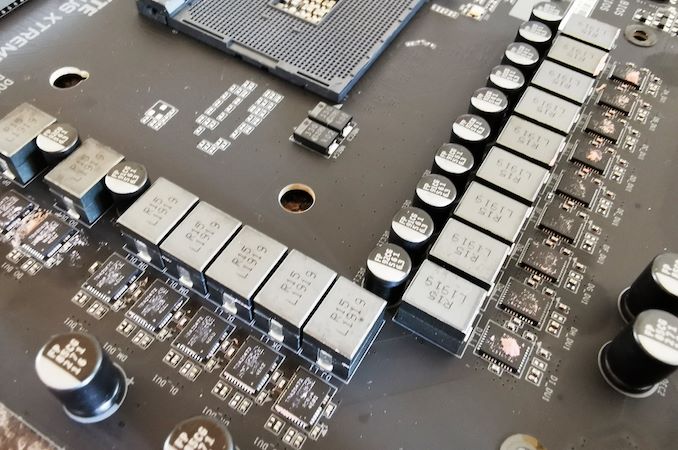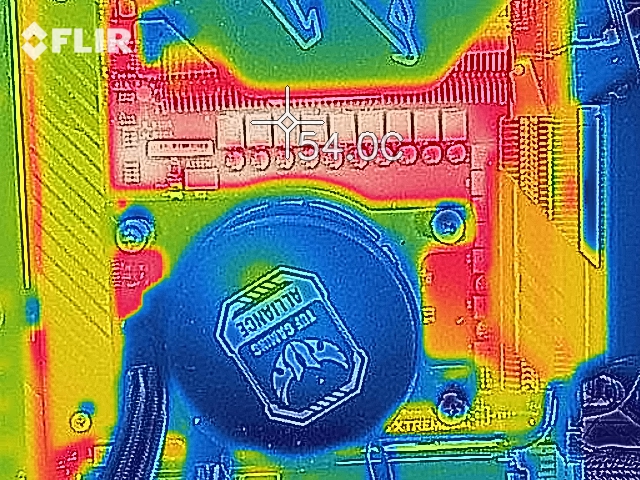The GIGABYTE X570 Aorus Xtreme Motherboard Review: Fanless AM4
by Gavin Bonshor on September 24, 2019 9:00 AM ESTGIGABYTE X570 Aorus Xtreme Conclusion
As it currently stands, the GIGABYTE X570 Aorus Xtreme sits atop its current X570 product stack as the flagship model from its gaming-focused Aorus brand. Not only is it one of the most expensive models with an MSRP of $700, but it has competition from a couple of motherboards including the already reviewed MSI MEG X570 Godlike ($700), and the ASUS ROG Crosshair VIII Formula ($700). One primary feature that sets the X570 Aorus Xtreme apart from any other X570 model at present is its use of a completely passively cooled chipset heatsink. Every other X570 motherboard on the market relies on a cooling fan to keep the warm running X570 chipset cool.
The bulk of the X570 Aorus Xtreme's feature set is based on a highly premium set of controllers including an Aquantia AQC107 10 GbE and a Realtek ALC1220-VB HD audio codec which is assisted by an ESS Sabre ESS9218 digital to analogue converter for better audio capabilities. Also present is a second Ethernet port controlled by an Intel I211-AT Gigabit NIC and the inclusion of an Intel AX200 Wi-Fi 6 802.11ax capable wireless interface is likely to be popular with users looking to make the most of BT 5.0 connectivity too.
One of the most important traits for overclockers is the power delivery and the X570 Aorus Xtreme has one of the most formidable out of all the current X570 product stack. It consists of a 16-phase design split into a 14+2 configuration with the use of Infineon's new 16-phase XDPE132G5C digital PWM controller. Each of the sixteen phases consists of an Infineon TDA21472 70 A power stage and comes supplied with an inductor. GIGABYTE's decision to include such a powerful and efficient looking power delivery will be popular to sub-zero overclockers and enthusiasts looking to push the limits of the Ryzen 3000 processors. In our overclocking testing, the X570 Aorus Xtreme performs superbly with a positive impact on power consumption at full load with our Ryzen 7 3700X testbed processor. Not only is the power draw more efficient with our processor than other models on test, but it translates well into the thermal properties with the lowest power delivery temperatures of any board we've tested so far. This can be attributed to the quality of the power delivery, as well as the robust power delivery heatsink that's hidden away under the beautiful rear panel cover.
Touching more on the aesthetics, the all-black design which comprises of a rear panel cover, a PCB dominating coating of GIGABYTE's reactive thermal armor, and the reinforcing nanocarbon coated backplate on the rear all a touch of class at the expense of overall weight. The X570 Aorus Xtreme is a heavy-duty model in both aspects and for users looking to add a little flair to their system, the integrated RGB zones and the ability to add more via the use of integrated ARGB and RGB headers gives users the ability to do this. The old debate of RGB versus non-RGB remains hotly discussed on various internet forums, but with the RGB LEDs switched off the X570 Aorus Xtreme is one of the best-looking motherboards to date from GIGABYTE.
General system performance is competitive with a good showing in idle state power consumption and at full load. We did pick up what seems to be an anomaly in our long idle power testing which was considerably higher than other boards on test, but we did run this test multiple times and kept getting the same type of result. Not only was system performance competitive, but the results in our CPU and game testing yielded similar findings. In our Handbrake testing, the X570 Aorus Xtreme performed on par with the GIGABYTE X470 Gaming 7 WIFI which we tested during the launch of the X570 chipset; this could be an attribute in the wiring of the components within the boards PCB, but all other scores did seem to be in-line with what other vendors have to offer from our testing.
Overclocking testing was a standout point which is no surprise given the X570 Aorus Xtreme is geared up for extreme overclocking and enthusiasts with its aforementioned true 14-phase power delivery for the CPU. Our testing showed quite tight VDroop control at all of the frequencies testing with the biggest over compensation coming at our max overclock of 4.3 GHz at 1.375 V; the maximum load voltage observed was 1.380 V which is a 0.05 V increase over the set value. Performance in our POV-Ray benchmark also jumped up incrementally as we tested each 100 MHz ratio step as expected and we were glad to see Precision Boost Overdrive did make a noticeable improvement over stock for the first time on X570. This is likely down to the new firmware, but there is a lot of talk at present on boost clock values achieved on Ryzen 3000 processors when comparing older and newer firmware; something we don't want to speculate on. Either this is observed from, the GIGABYTE X570 Aorus Xtreme performs very well.
GIGABYTE includes support for DDR4-4400 memory and has support for up to 128 GB of system memory across its four available memory slots. Storage is also important to factor in with three PCIe 4.0 x4 M.2 slots which each includes individual heatsinks, but the bottom-mounted slot does share bandwidth with two of the six SATA ports which are present on the board. On the rear panel is plenty of USB connectivity to utilize with five USB 3.1 G2 Type-A, one USB 3.1 G2 Type-C, two USB 3.1 G1 Type-A, and four USB 2.0 ports. For users looking to maximise the boards potential with water cooling, the eight 4-pin fan headers can be expanded by a further eight 4-pin headers with the inclusion of the bulky, yet functional Aorus RGB Fan Commander in the accessories bundle.
For enthusiasts and performance users, the GIGABYTE X570 Aorus Xtreme does little wrong to solidify its position as one of the top X570 motherboards on the market. While it does come under GIGABYTE's Aorus gaming based brand, the X570 Xtreme is much more than that with plenty of connectivity for cooling, overclocking, and even more USB on the rear panel that would be expected. With its solid and high-performance 16-phase power delivery combined with elegant and PCB covering armor, the X570 Xtreme is the board that enthusiasts that aren't put off by the $700 price tag looking to build an AM4 based gaming system should be looking towards. It has the features, it has the looks and it has the power delivery to make it one of the best X570 boards at present and even without a lot of fluff or fanfare, it sits as the only model without an actively cooled chipset heatsink and that just adds to the allure.












42 Comments
View All Comments
Anderson6 - Thursday, October 10, 2019 - link
The new, advanced power and thermal design enables users to unleash the performance on AMD Ryzen™ 3000-series Processors, making the GIGABYTE X570 motherboards perfect for users looking to build the best AMD platform gaming system. GIGABYTE X570 motherboards maximize your PC's potential with AMD StoreMI technology https://www.upsers.club/RyanTech - Saturday, November 2, 2019 - link
First of all, thanks for the great review! Well-written and very informative. I just have one question: Where is the last 4x lanes from the chipset usable from?I understand that the x16 and the x8 expansion slots and the M2A slot uses (20 total) lanes from the CPU and the last x4 expansion slot together with the M2B and M2C slots uses lanes from the chipset at 4x lanes each.
But if I understand correctly, that's only 12 of 16 lanes so far for this platform & motherboard (4x for expansion slot 3, 4x each for the 2nd and 3rd M.2 slots). Where are the other 4 lanes? It can't be the SATA ports, right? Because the chipset already supports 4x SATA ports natively.